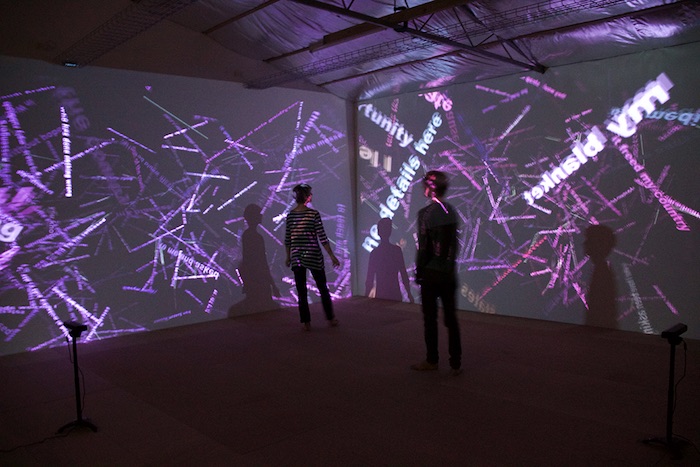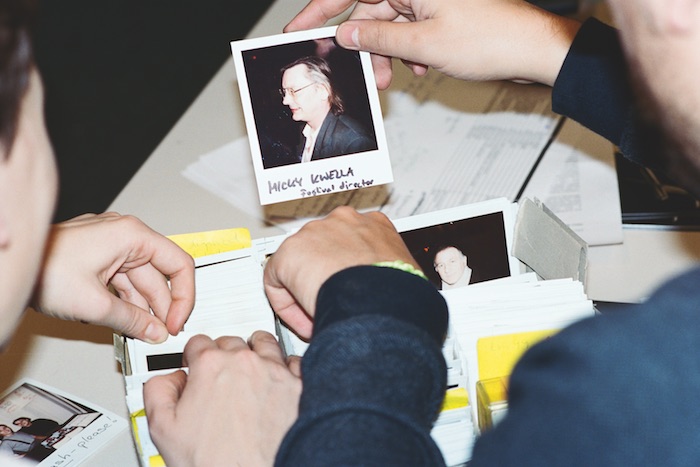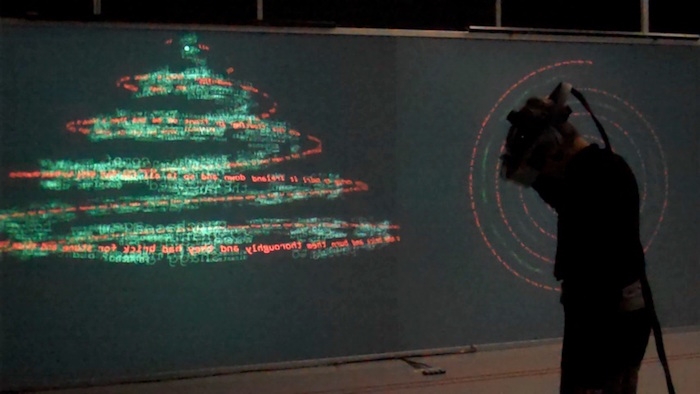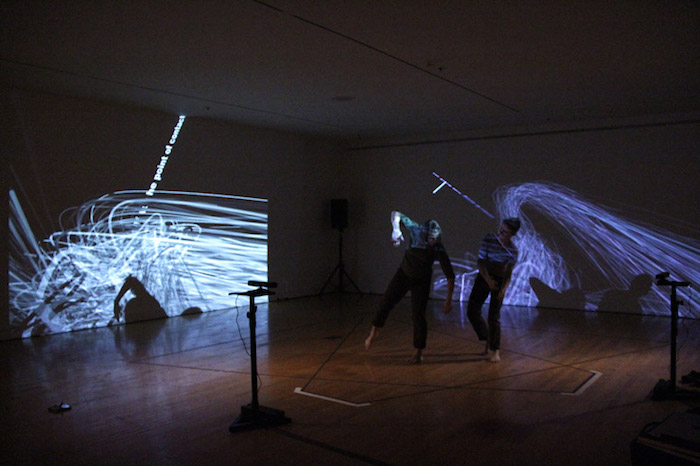The Blue Screen Interviews: 1995/2017
The Blue Screen Interviews: 1995/2017
As part of the recent initiative to digitize archival material, the original Blue Screen videos have now been made available online. To mark their release, one 1995 participant, the artist Simon Biggs, has been asked to respond to the original questions again, which are presented here alongside his original answers. Biggs was also curator of the multimedia exhibition at that year’s festival, so at the time he was in the thick of meditations on the meaning of the medium. Some aspects of aesthetic practice are timeless, but this re-interview exposes telling gulfs between then and now. As Biggs put it: “My answers to these questions are quite different now to what they were more than two decades ago. Things have changed and my understanding of things has also changed.” That’s no understatement.
Each original Q&A is followed by the 2017 version. Some questions have been updated to be retrospective rather than predictive. The full video interview can be watched below.
*
1995: What do you think about the influence of multimedia on social communication?
It’s too early to say whether what you’re calling multimedia will become the primary means of communication in our culture. It seems likely that it will replace other means. One of the most striking aspects of multimedia is its multivalent presence in terms of both authorship and reception. That would tend to suggets that, if it becomes the primary means of social discourse and production of social meaning, both within subcultures and within the mainstream of society, there will be major shifts in society itself.
Society—a social formation, you could call it society or culture—is more or less a function of the structures of communication that the society has created. I’m not going to get into a debate about whether communication creates a society or a society creates the communication forms—I think it’s a dialectic, a complex structure where the two inform one another with other factors as well. The impact of multimedia on our culture is not just about multimedia, it’s about a whole lot of political issues, about postcolonial culture, about the end of the Cold War, all these issues are relevant too. You can’t take a question like the impact of new technologies on culture in isolation; you have to look at it in a much broader social, political, economic way. There’s a lot that’s been happening in the world in the last 50 years and especially within the last 10 yearsm which is very exciting. Technology is only one element in that process.
The idea of fragmentation does seem to be a rather fundamental social dynamic, the idea that different cultures can exist in parallel and connect, that there is a possibility for pluralistic communication and a pluralistic notion of the origin of meaning, and therefore the origin of power in our culture. And of course communication is at the center of that.
2017: What do you think the influence of multimedia on social communication has been?
As we now appreciate, multimedia is part of the lineage of what we now understand to be social media. Social communication has, with the emergence of the internet, been technologically mediated to such a degree we now refer to a large part of communication as social media. The term social media is becoming all-encompassing, to include previously distinct medial forms such as visual communication, journalism and reportage, the expressive arts, and education. New medial forms are also developing. This reflects what media has always been—social and communicative. The question is whether, through this process, we lose sight of how media function to create and control social formation. We need to remain alert to these dynamics in order to appreciate how things come to be and their implications for society.

1995: It is said that our thinking and perception is linear. Multimedia is non-linear. Do you think our thinking and perception will change in response to multimedia over time?
Can I appropriate your question? I do not believe that thinking is linear. The whole concept of linearity doesn’t exist. I think thinking has nothing to do with time. And I think identity has very little to do with time. It has a lot to do with memory. Memory is random access; memory is associative, it’s poetic, and the formation of the self is a function of that, and so is the formation of meaning. So for me, and this is a very personal statement as an artist, this is one of the things that attracts me to interactive media: that you have a potential for poetic association that is more like how the brain works. I would argue that forms like film, theater, and especially television and video art, are not naturally human means of thinking. The novel is slightly more natural, because you can jump around, you are in control as a reader, and you’re not forced into somebody else’s conception of time.
One of the nice things about the really new technologies is that they bring us back to the most natural state of human thought, which has nothing to do with the conventions we’ve been subject to for the last hundred years or longer. The more nonlinear, the more random access, the more associative—I think these new technologies allow that to function, not only in the character of the work but also in the formation of the work and the reading of the work. In a sense I feel we’re getting back to a notion of a very close relationship between the artwork, the process of art production, the process of reading, all as an integral social thing. In the same way that storytelling was, or playing music around the fire was.
That’s some potential I see, but whether it’s realized is another question. I’m sure that individual artists, events, and institutions will promote that type of work. The real question is whether the media moguls will allow that to develop in the mainstream, and that of course is really unknown. I think it’s unlikely that they would.
2017: Have our thinking and perception changed in response to multimedia over time?
Do we still think about multimedia? In the 1990s we were in a period of technological convergence, where having diverse media encoded together was an interesting novelty. What was once multimedia is now something else, and no longer novel, becoming so pervasive it is now an invisible infrastructure. We live outside the black box that is our socio-technical apparatus. That is to say, most people are unaware of how the technologies that underpin most aspects of their lives work or interact with one another (this could be described as a post-medial condition). At the time of the original transmediale interviews, in the mid-90s, Michel Foucault offered a compelling analysis of our society, viewing it as a panoptic apparatus of creation and control. I think that his work remains compelling and his ideas are even more important if we are to understand contemporary society.

1995: Do you have criteria for when a multimedia product becomes art?
No. For me the most important question is not whether something is art or not, but whether it’s interesting, it’s creative, and it’s coming from positive motivation. The motivation may at first appear negative, in the case of, say, transgressive art, in the case of pornography, or S&M, or violence— on the surface, these things can appear to be negative, but in the right hands, in the right way, they can be positive.
I don’t think the question is a distinction between art and not-art. It’s really a question of whether something is good, effective, creative, inspirational. For me the most important word is transcendental, in the sense of taking both its author and its reader beyond themselves, beyond what they’ve known.
2017: Do you have criteria for when a multimedia product becomes art?
No. My answer to this question has not changed. Things do not become art due to their own properties. Things become art because of how they exist relationally with other things, including people. Whether a multimedia product is considered art (or not) is a function of, in part, intentionality (the producer’s intention to make art) and apprehension (the consumers appreciation of something as art). Alternatively, within the framework of the institutional definition of art, a multimedia product is art if it is accepted into the institutionally defined canon of art. I don't have much time for this latter definition as it is corruptible and corrupting.

1995: Do you think that the definition of art will change through multimedia?
I think there’s a real problem in the relationship between art and multimedia. I guess I’m a multimedia producer, and I still think of myself as an artist, but I can imagine that for a lot of people working in this field, they’d rather not be thought of as artists. They feel that to be thought of as an artist relegates them to the museum, to the life of the dead. And I have a sympathy with that. Whether multimedia affects art or not, I don’t think this is very important. It’s much more important how it affects society. And I would think that’s how an artist thinks too. At least a good one would be thinking not about whether their work is art or not, but whether it has an effect on people and the cultures they live in.
2017: Do you think that the definition of art has changed through multimedia?
The answer to this question depends on whether you think art is defined relationally or insitutionally. If relationally, then yes, art has changed through multimedia—and due to many other factors as well. Relationally defined art is in constant flux, as are the relationships that define it. If you define art institutionally, then no, art cannot change.

1995: What do you think is the best way to present multimedia in a public space?
I think that within a public environment the presentation and contextualization of interactive multimedia is almost an impossibility. At least in the form of the desktop work—the point-and-click environment, the computer on a desktop with a mouse. That’s intimate and should be presented as intimate. I think it’s possible for festivals, museums, and galleries to present this work, but they have to recognize that it’s only a limited dimension that the viewer is getting. The real place they should focus their attention is environmental rather than desktop work: works where eight people or 20 people or nth-number of peopole can interact together with each other and with the work.
2017: What do you think is the best way to present multimedia artwork in a public space?
Technological advances in video projection and other immersive media have meant that what were once intimate media, experienced primarily via a desktop computer, can now be experienced in large-scale shared environments by interacting viewers or readers. Advances in mobile technology have meant that intimate engagement with media-based work can be sustained without being tethered to a desktop workstation. We can experience media-based work almost anywhere and/or anytime. Advances in network technologies allow such intimate experiences to become shared experiences. All three of these approaches can be combined in various ways to create a diversity of medial experiences that can be intimate and shared, public and private, all at the same time. There's no best way to do this. I continue to develop my own creative strategies, experimenting with a diverse range of approaches. In my own practice, interactivity (physical and poetic) remains key in how people experience the work. Probably the most important aspect of this is understanding that people construct their own reading of a work and that a variable and interactive (open) work can enhance their appreciation of this process. It is easier to make such works using new media (specifically, computational media) but it can be achieved using old media. As I observed in the original transmediale interview, the book has some of these properties.

1995: For art it is very important that there’s a relation between the viewer and the artwork. But if you use multimedia, you are not only a viewer, you are a user. Does this lead to something like the end of art?
For me the primary issue is not the relationship between the viewer and the work of art, but the relationship between the viewer and the author. The work of art is just the medium. One of the beauties of interactivity and interactive systems is that they make explicit this relationship: the viewer becomes hyper-aware of the relationship between themselves and their relationship to the environment, to the work. They become aware enough that perhaps they come to regard themselves as the subject of the work, so their gaze is directed back on themselves. I think the author does that because the author is the viewer too. And as author, you’re looking for ways to dissolve distinctions between you and them, artist/viewer, author/reader, black/white, us and them. Just to dissolve these boundaries, to look for new ways of being. This is what I said before about transcendence.
2017: When interacting with multimedia, one is not only a viewer but also a user. How do you think the progression of viewers becoming users has changed art-making?
I find the term “user,” largely derived from gaming, unuseful, as it diminishes the agency of the person engaging a work. I also find the term “viewer” unuseful, as it doesn't evoke the active agency that is possible when encountering media-based work. I do like the term “reader,” as that suggests a more active role for the reader in the construction of meaning—but it might be understood to be limited to language-based work. The term I prefer to use to describe the subject in this kind of engagement is “interactor.” This term could be understood within an Actor-Network-Theory framework, where agency is recognized as distributed across numerous agents in the media system, including the interactor. This posits the entire work as a kind of system, or apparatus, with the interactor as an active element within that. My own view is that the entities (or agents) that comprise such a system are not stable but motile and dynamic in their ontology, as is the whole system. My work seeks to evoke this unstable, variable and relational contingency of context and self.

1995: I’ll give you two simple words, and I’d like you to give a short statement. The words are: future and multimedia.
You can’t write the future.
2017: I’ll give you two simple words, and I’d like you to give a short statement. The words are: future and multimedia.
The future will not be written...





